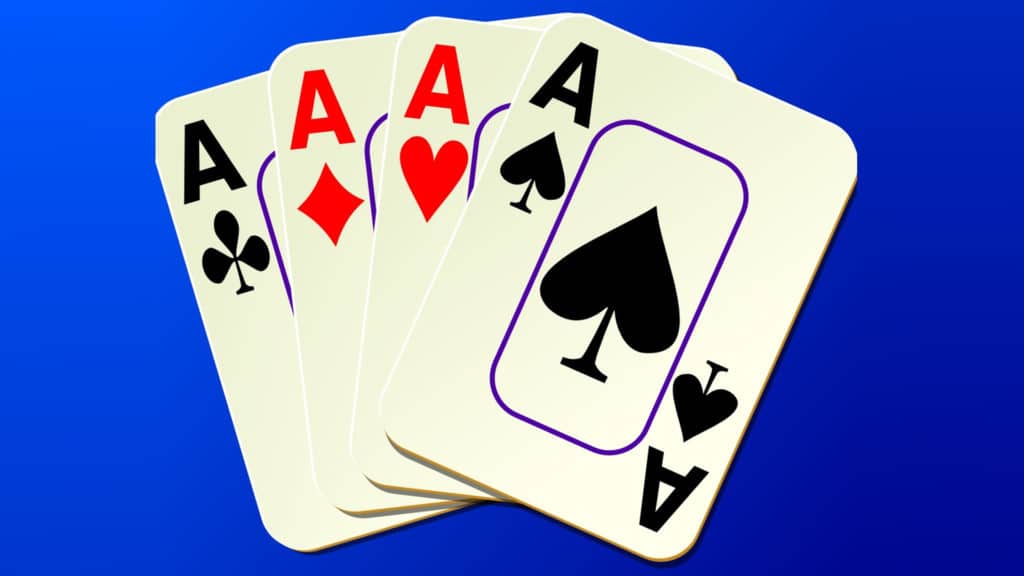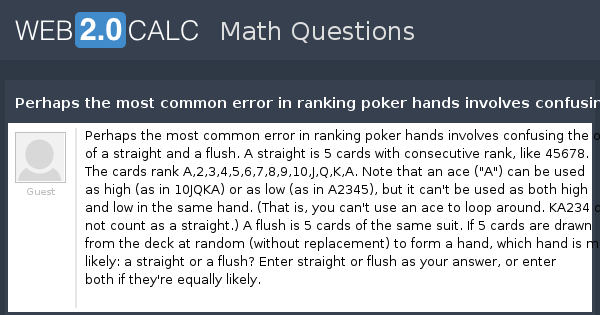Poker Can A Straight Wrap Around
Ha ha sadly the wrap-around straights (also known as round-the-corner or Miller straights) are not part of traditional poker hands. These hands are generally only used as special hands in private house games, but would have no advantage in a actual poker game at a casino or online poker room. The minimum Straight Wrap Around Poker qualifying deposit is €/$10. Deposits with Skrill or Neteller do not qualify for this bonus offer. The bonus offer is available to players from: Andorra, Gibraltar, Malta, Iceland, Liechtenstein, Monaco and Luxembourg.
In the hand (Wild) 6♥ 5♦ 4♥ 3♦, it plays as a 7 (even though a 2 would also make a straight). Wrap-around straight: Also called a round-the-corner straight, consecutive cards including an ace which counts as both the high and low card. (Example Q-K-A-2-3). PokerNews.com is the world's leading poker website. Among other things, visitors will find a daily dose of articles with the latest poker news, live reporting from tournaments, exclusive videos.
:Introducing Computer Science 2/e Copyright (C) 1999 MIT
|
The idea of this project is to invent a procedure poker-valuethat works like this:
As you can see, we are representing cards and hands just as in theBridge project, except that poker hands have only fivecards.[1]

Here are the various kinds of poker hands, in decreasing order of value:
| • | Royal flush: ten, jack, queen, king, and ace, all of the same suit |
|---|
| • | Straight flush: five cards of sequential rank, all of the same suit |
|---|
| • | Four of a kind: four cards of the same rank |
|---|

| • | Full house: three cards of the same rank, and two of a second rank |
|---|
| • | Flush: five cards of the same suit, not sequential rank |
|---|
| • | Straight: five cards of sequential rank, not all of the same suit |
|---|
| • | Three of a kind: three cards of the same rank, no other matches |
|---|
| • | Two pair: two pairs of cards, of two different ranks |
|---|
| • | Pair: two cards of the same rank, no other matches |
|---|
| • | Nothing: none of the above |
|---|
An ace can be the lowest card of a straight (ace, 2, 3, 4, 5) orthe highest card of a straight (ten, jack, queen, king, ace), but a straightcan't 'wrap around'; a hand with queen, king, ace, 2, 3 would be worthless(unless it's a flush).
Notice that most of the hand categories are either entirely about the ranksof the cards (pairs, straight, full house, etc.) or entirely about thesuits (flush). It's a good idea to begin your program by separating therank information and the suit information. To check for a straight flush orroyal flush, you'll have to consider both kinds of information.
In what form do you want the suit information? Really, all you need is atrue or false value indicating whether or not the hand is a flush, becausethere aren't any poker categories like 'three of one suit and two ofanother.'
What about ranks? There are two kinds of hand categories involving ranks: the ones about equal ranks (pairs, full house) and the ones about sequentialranks (straight). You might therefore want the rank information in twoforms. A sentence containing all of the ranks in the hand, in sorted order,will make it easier to find a straight. (You still have to be careful aboutaces.)
For the equal-rank categories, what you want is some data structure thatwill let you ask questions like 'are there three cards of the same rankin this hand?' We ended up using a representation like this:
One slightly tricky aspect of this solution is that we spelledout the numbers of cards, one to four, instead of using the moreobvious (1 Q 2 3 2 4). The reason, as you can probably tell just bylooking at the latter version, is that it would lead to confusion betweenthe names of the ranks, most of which are digits, and the numbers ofoccurrences, which are also digits. More specifically, by spelling out thenumbers of occurrences, we can use member? to ask easily if there isa three-of-a-kind rank in the hand.
You may find it easier to begin by writing a version that returns only thename of a category, such as three of a kind, and only after you getthat to work, revise it to give more specific results such as threesixes.
Poker Can A Straight Wrap Around Blouse
Extra Work for Hotshots
In some versions of poker, each player gets seven cards and can choose anyfive of the seven to make a hand. How would it change your program if theargument were a sentence of seven cards? (For example, in five-card pokerthere is only one possible category for a hand, but in seven-card you haveto pick the best category that can be made from your cards.) Fix yourprogram so that it works for both five-card and seven-card hands.
Another possible modification to the program is to allow for playing with'wild' cards. If you play with 'threes wild,' it means that if there isa three in your hand you're allowed to pretend it's whatever card you like.For this modification, your program will require a second argument indicatingwhich cards are wild. (When you play with wild cards, there's thepossibility of having five of a kind. This beats a straight flush.)
[1] Later on we'll think about seven-card variants of poker.BACKchapter thread NEXT
Brian Harvey,
bh@cs.berkeley.eduPoker Can A Straight Wrap Around Porches
One of the biggest adjustments players new to Pot-Limit Omaha need to make is to the size of possible straight draws, it is possible to hold a straight with no less than 20 ‘outs’ on the flop in PLO Poker – yet many players make huge errors with these holdings.
This is the first part of a 3 article series which will look at straights and wraps in PLO Poker in some detail. Here we examine the variety of straight draws available and the starting hands which give you the potential to flop the largest of these draws. We will also look at ‘trap wraps’ by covering scenarios where not all of your outs are clean.
In the second part of this series we look at wraps with help – that is to say those times when you have additional ways to win a showdown such as flushes or a pair. The 3rd part will look into Omaha flop hand match-ups which involve wraps against a variety of opponent holdings.
Wraps In Pot Limit Omaha – Hierarchy Of Common Straight Draws

1 – Gutshot Straight Draw – 4 Outs – Example: A-2-9-J on a flop of 4-5-8
2 – Open Ended Straight Draw – 8 Outs – Example: 4-5-Q-Q on flop of 6-7-K
3 – Inside Broadway Draw – 9 Outs – Example: 5-10-J-K on flop of 7-Q-A
4 – 12 Out Straight Draw – 12 Outs – Example: 7-9-J-Q on flop of 2-8-10
4 – 13 Card Wrap Draw – 13 Outs – Example: 5-6-8-9 on flop of 4-7-K
6 – 17 Card Wrap Draw – 17 Outs – Example: 10-9-6-2 on flop of 8-7-A
6 – 20 Card Wrap Draw – 20 Outs – Example: 10-9-6-5 on flop of 8-7-2
When considering the power of wrap around straight draws we need to consider several inter-relating factors. These include the following questions:
What Starting Hands Produce The Most Powerful Omaha Wrap Straight Draws?
Here is the key ‘Wraps Love Gaps ’, that is to say you need gaps in your starting hand in order to flop the best possible wraps. Within this there is a proviso – that the ‘2-gap’ hands which can produce the biggest wrap draws of all are not necessarily the most desirable pot-limit Omaha starting hands, since not all your outs are to the nuts, especially when the gaps are at the top end. High-card strength and / or suitedness (along with good table position) can really help with these hands.
How Many Of My Outs Are To The Nuts?
It is easy to find yourself counting a huge number of outs, only to find that less than half of them are to the nuts. Chasing a ‘Sucker-Wrap’ can be hugely expensive in Omaha, you will find yourself winning a small pot or losing a big one to a better draw. If you have a read (for example that your opponent has a set), or help (for example a flush draw or pairs) then non-nut wraps can be played more aggressively.
Is There A Flush Or Flush Draw Available On The Flop?
Key to the power of your wrap is whether the flop contains 2 suited cards, if you do not have a flush draw yourself then this can devalue your hand significantly. Against multiple opponents even the strongest wraps should be given up on a monotone (single suit) flop when you have no help. Position is key to playing wraps where other draws are possible, since this will often allow you to better control the size of the pot.
What Is The Likelihood That Some Of My Outs Are In Opponents Hands?
When considering a broadway (picture card) wrap draw it is important to consider that your opponents may be holding a number of your outs. Since high cards and connected cards are more likely to be in the pot pre-flop, it can be possible for several cards to be taken. For example when playing an inside broadway straight against 2 opponents it is feasible that you could end up with a split pot more than half of the time – and an opponent with the same straight draw and a set could be freerolling for the full house on later streets.
Poker Can A Straight Wrap Around Neck
How Deep Are The Chip Stacks, And Where In The Betting Order Do We Sit?
While the depth of stacks and position are more a key strategy component with PLO poker than specific to wrap draws – the strength of your draw and position are closely related. This becomes most apparent when your flop bet is flat called and the turn does not complete your draw. Changing from a solid favorite to an underdog to win the pot means that position or the ability to threaten your opponent with a potentially large re-raise are key weapons.
Poker Can A Straight Wrap Around Porch
Part 2 of our series looking at straight and wrap draws on pot limit Omaha poker will examine those times when you have a wrap plus some further help in the hand.



